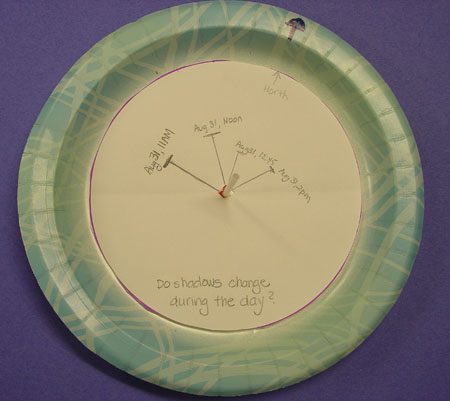|
|
|
|
|
|
|
|
|
|
VOCABULARY
MATERIALS:
BACKGROUND: This
long term project helps students to see that the Earth does not travel in
the same position. The Sun
changes orbit around the Earth.
It changes its location in the sky.
During the summer it is high from the horizon and in the winter it
is low in the horizon. The position of the Sun in the sky will affect the
length of the shadow. A
shadow is an area where light from a light source is obstructed by an
object. It occupies all of the space behind an opaque object with light in
front of it. The cross section of a shadow is a two-dimensional
silhouette, or reverses projection of the object blocking the light.
Sunlight causes many objects to have shadows at certain times of the day.
The angle of the sun, its apparent height in the sky causes a change in
the length of shadows. Low-angles create longer shadows.
This exercise is to help them how to measure a shadow and as they
collect data throughout the year, what does it mean.
QUESTIONS:
Does the
shadow of the Sun change from fall to spring?
BACKGROUND:
Students are collecting
data that they measure. Length
of shadow of a “shadow stick” child should be put in a data book.
PRIOR RESEARCH FOR CLASS:
How to measure
EXPERIMENTAL DESIGN:
A site should be selected where maybe 5 students can be measured at one
time. Draw where the Sun is in
the sky. Probably should make
a grid of sky. Measurement
should be either monthly or bimonthly. School has to decide to do in
metric or English system.
CONCLUSION:
Discussion should center on
·
what
causes a shadow (sometimes gets in the way of light);
·
does it
change during the year (yes) PROCEDURE:
1.
Ask the students which way
is north. Many will say "up," as if the north pole is in the sky.
Describing the direction of the north pole is difficult, because north, in
and of itself, describes location.
With a globe show students where north and south
is located.
Ask them again if north is up. It should now be clearer to them that north
and south are directions on the Earth’s surface.
2.
Ask the students from what
direction the Sun appears to rise (the East). Ask them if they can use
this knowledge to find North, West, and South. Go over this carefully with
the students. West would be directly opposite east. North would be left of
east-west line and south would be right of the east-west line. Ask the
class in what direction the Sun sets (the West). Ask them what direction
the Sun moves in the sky (East to West). Go outside and see if students can figure out where the Sun rises. That would be East, which is in the direction of Mission Peak. Use your arms to show them that west is directly opposite… 180 degrees or a straight line. The Sun crosses from East to West in the southern part of the sky…. So South is 90 degrees away. North would be 180 degrees from south. 3. Point out that the globe is tilted, and explain that this is because the Earth is tilted on its axis relative to the Sun. Explain how this causes the seasons. Some students may notice that when the northern hemisphere tilts away from the Sun, the southern hemisphere tilts toward the Sun. Explain that our summer season is the winter season in the southern hemisphere.4. In the following activity students will learn how to record shadows.As their class project they will chart this through the months to determine if there is a change or not.  5. Go outside to the
playground, and have the students find the shadow cast by a pole. If many
shadows are available, divide the class into groups. Have the students
outline the shadow, or a portion of it, with chalk. 5. Go outside to the
playground, and have the students find the shadow cast by a pole. If many
shadows are available, divide the class into groups. Have the students
outline the shadow, or a portion of it, with chalk.
6. Make a shadow plate that students will collect data from. (see example). Use dinner plates and use two magnets. 7. Collect the data toward the end of experiment.
|